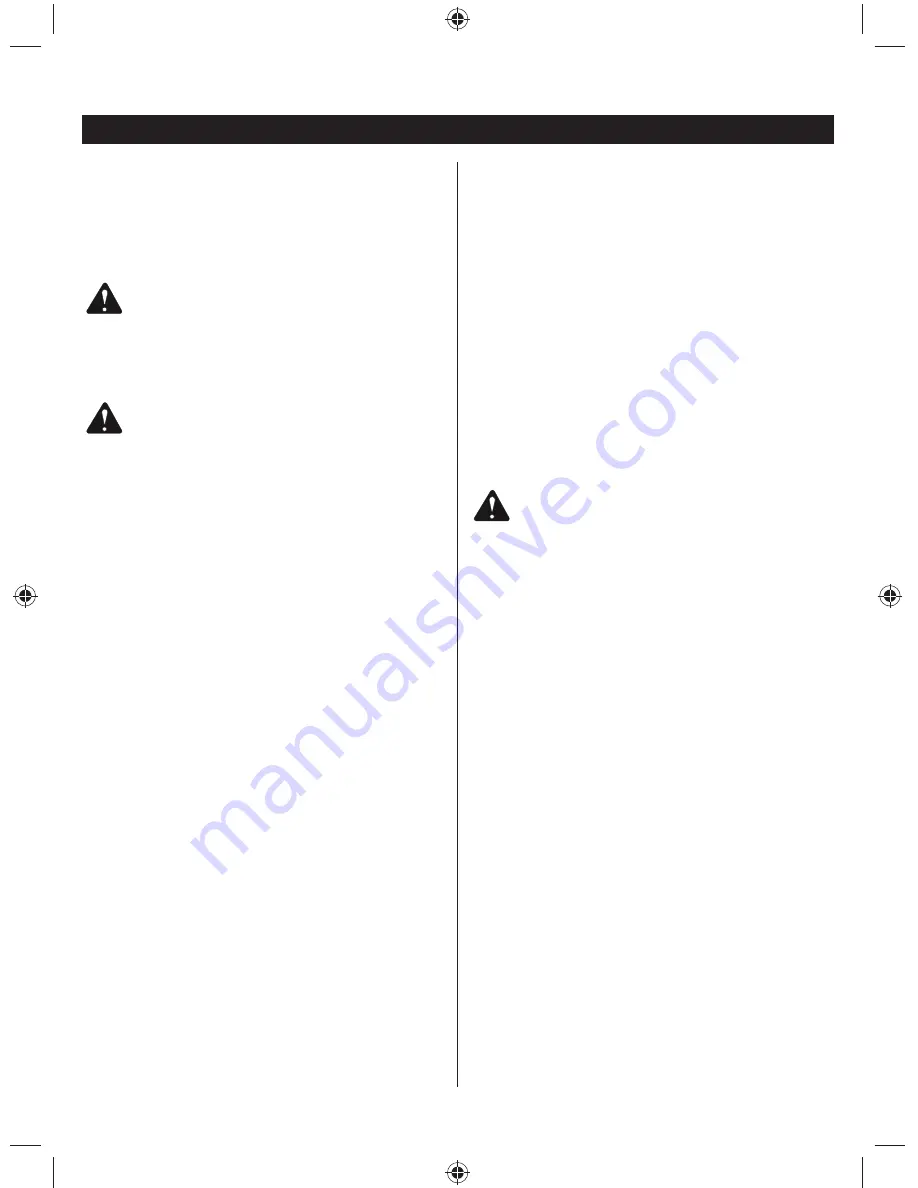
19
English
All of the bearings in this product are lubricated with a
sufficient amount of high grade lubricant for the life of
the unit under normal operating conditions. Therefore, no
further lubrication is required.
REPLACING THE GUIDE BAR AND CHAIN
See Figures 35 - 44.
DANGER
Never start the engine before installing the guide
bar, chain, clutch cover, and clutch drum. Without
all these parts in place, the clutch can fly off or
explode, exposing the user to possible serious
injury.
WARNING
To avoid serious personal injury, read and
understand all the safety instructions in this
section.
Always place the switch in the
stop
“0” position
before you work on the saw.
Make sure the chain brake is not set by pulling the
chain brake lever/hand guard towards the front
handle to the run position.
Note:
When replacing the guide bar and chain,
always use the specified bar and chain listed in the
Bar and Chain Combinations section listed earlier in
this manual.
Wear gloves when handling the chain and bar. These
components are sharp and may contain burrs.
1. Remove the bar mounting nuts using the combination
wrench provided or 13 mm socket wrench, then
remove the clutch cover.
2. Remove the bar and chain from the mounting surface.
3. Remove the old chain from the bar.
4. Lay out the new saw chain in a loop and straighten any
kinks. The cutters should face in the direction of chain
rotation. If they face backwards, turn the loop over.
5. Place the chain drive links into the bar groove as
shown.
6. Position the chain so there is a loop at the back of
the bar.
7. Hold the chain in position on the bar and place the loop
around the sprocket.
8.
)LWWKHEDUÀXVKDJDLQVWWKHPRXQWLQJVXUIDFHVRWKDW
the bar studs are in the long slot of the bar.
9. Replace the clutch cover ensuring that the adjusting
pin in the clutch cover is in the bar tensioning pin hole
and that both bar studs are in their respective holes in
the clutch cover.
10.
5HSODFHDQG¿QJHUWLJKWHQWKHEDUPRXQWLQJQXWV7KH
bar must be free to move for tension adjustment.
11. Remove all slack from the chain by rotating the chain
tensioning screw clockwise until the chain seats snugly
against the bar with the drive links in the bar groove.
12. Lift the tip of the guide bar up to check for sag.
13. Release the tip of the guide bar and turn the chain
tensioning screw 1/2 turn clockwise. Repeat this
process until sag does not exist.
14. Hold the tip of the guide bar up and tighten the bar
mounting nuts securely. The chain is correctly
tensioned when there is no sag on the underside of
the guide bar, the chain is snug, but it can be turned
by hand without binding. Ensure that the chain brake
is not set.
Note:
If chain is too tight, it will not rotate. Loosen the
bar nuts slightly and turn the tension adjuster 1/4 turn
counterclockwise. Lift the tip of the guide bar up and
retighten the bar nuts securely. Ensure that the chain
will rotate without binding.
MAINTAINING THE GUIDE BAR
See Figure 47.
WARNING
Check that the switch is in the STOP “0” position
on the saw.
Every week of use, turn over the guide bar on the saw to
distribute the wear for maximum bar life. The bar should
be cleaned every day of use and checked for wear and
damage. Feathering or burring of the bar rails is a normal
process of bar wear. Such faults should be smoothed
with a file as soon as they occur.
A bar with any of the following faults should be replaced:
Wear inside the bar rails that permits the chain to lay
over sideways
Bent guide bar
Cracked or broken rails
Spread
rails
Lubricate guide bar sprockets weekly. Using a grease
syringe, lubricate weekly in the lubricating hole. Turn the
guide bar and check that the lubrication holes and chain
groove are free from impurities.
CLEANING THE AIR FILTER
See Figures 48 - 49.
1. Ensure that the switch is in the STOP “0” position.
2. Activate the chain brake.
3. Remove the two screws holding the engine cover.
4. Lift the front of the engine cover past chain brake lever.
5. Lift the back of the engine cover past the handle.
6.
%HIRUHUHPRYLQJWKHDLU¿OWHUIURPWKHFDUEXUHWWRUEORZ
or brush as much loose dirt and sawdust from around
the carburettor and chamber as possible.
Note:
Make sure to pull the choke rod out to keep the
carburettor from being contaminated.
7.
/LIWWKHDLU¿OWHURIIWKHDLU¿OWHUEDVH






































